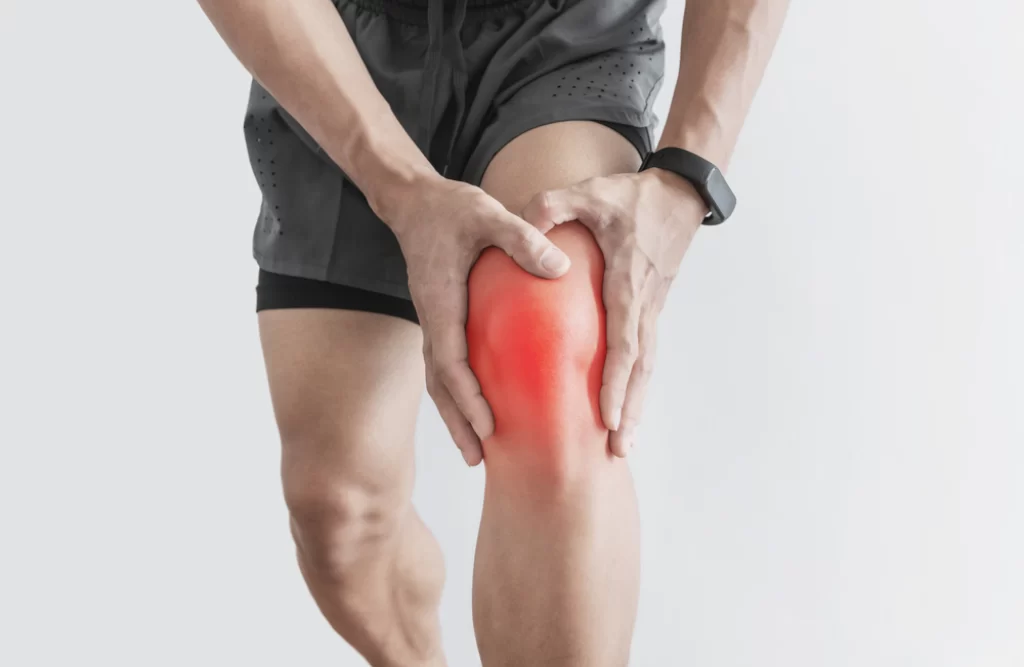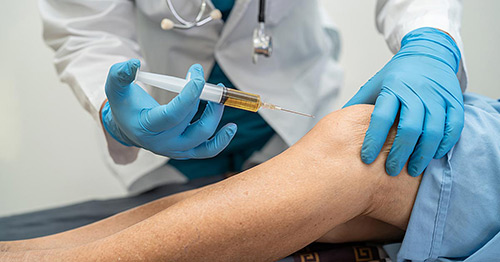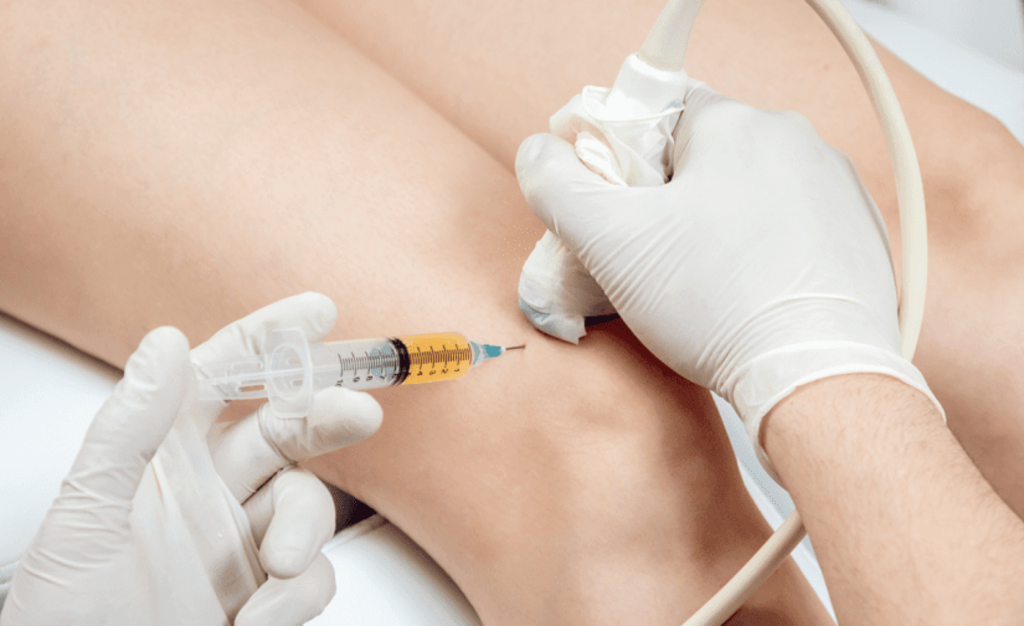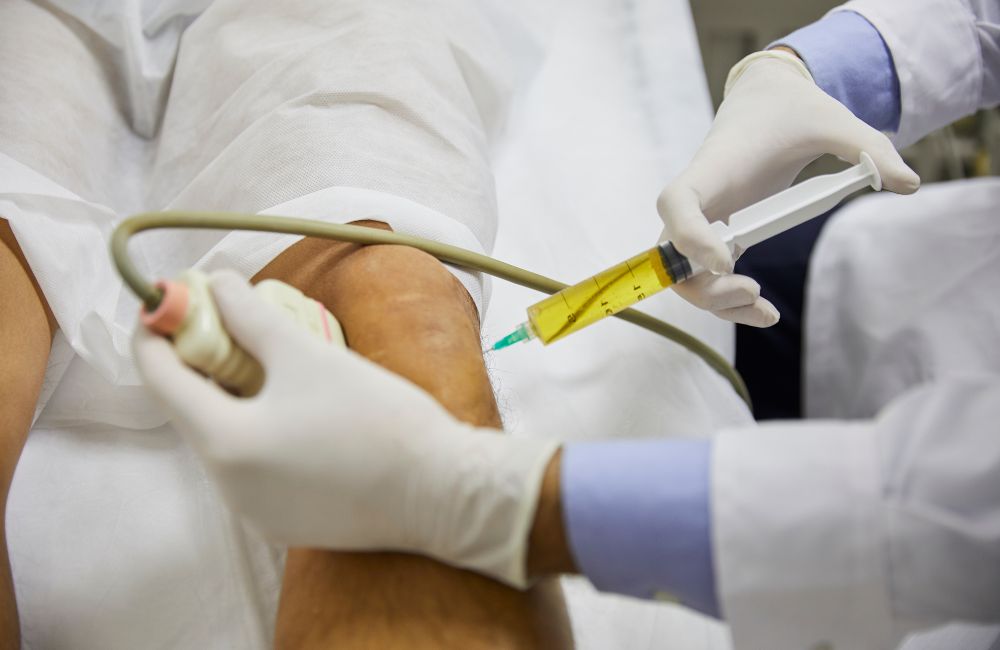Ligament injuries are a common occurrence, especially among athletes and individuals who engage in physical activities. Common causes of ligament injuries include sudden twists, impacts, or repetitive stress from activities such as running, jumping, or lifting. The annual reported incidence in the United States is roughly 1 in 3,500 people. PRP injections in CT are increasingly being used to treat these injuries, offering a non-surgical option that promotes healing and reduces recovery time.

What is a Ligament Injury?
A ligament injury refers to damage to one or more ligaments, which are strong, fibrous tissues that connect bones to other bones at joints, providing stability and support. Ligaments play a crucial role in maintaining the structural integrity of joints, allowing for controlled movement while preventing excessive motion that could lead to dislocation or other injuries.
Types of Ligament Injuries
- Sprains: These occur when ligaments are stretched beyond their normal range, resulting in micro-tears. Acute ankle sprains are among the most common musculoskeletal injuries, with an estimated 2 million cases occurring annually in the United States. Sprains are graded based on severity:
- Grade 1 Sprain: Mild overstretching with minimal fiber damage.
- Grade 2 Sprain: Partial tear of the ligament fibers, causing moderate pain and swelling.
- Grade 3 Sprain: Complete tear of the ligament, leading to severe pain, instability, and significant swelling.
- Tears: More severe than sprains, tears involve a partial or complete rupture of the ligament fibers. These injuries often require more intensive treatment and a longer recovery period.
- Chronic Ligament Conditions: Repeated stress and inadequate healing can lead to chronic conditions, such as tendinitis or ligament laxity, where the ligaments become loose and unstable, causing ongoing pain and functional impairment.
Commonly Affected Ligaments
- Ankle Ligaments: The most commonly injured ligaments in the ankle are the anterior talofibular ligament (ATFL) and the calcaneofibular ligament (CFL). These injuries are often the result of rolling or twisting the ankle.
- Knee Ligaments: The anterior cruciate ligament (ACL) and the medial collateral ligament (MCL) are frequently injured in sports involving sudden stops, jumps, and changes in direction, such as soccer, basketball, and skiing.
- Wrist and Elbow Ligaments: Ligament injuries in these areas are often seen in athletes who perform repetitive motions, such as tennis players and golfers, leading to conditions like tennis elbow and golfer’s elbow.
Symptoms and Diagnosis
Common Symptoms
- Pain: Sharp or throbbing pain at the injury site, often increasing with movement.
- Swelling: Rapid swelling around the injured area due to inflammation and fluid accumulation.
- Bruising: Discoloration of the skin caused by bleeding under the surface.
- Joint Instability: A feeling of looseness or weakness in the joint, making it difficult to support weight or move normally.
- Difficulty Moving the Affected Joint: Reduced range of motion and stiffness, making it hard to perform usual activities.
- Popping Sound: In severe cases, patients may hear a popping sound at the time of injury, indicating a possible tear or rupture.
- Immediate Swelling and Instability: Sudden swelling and a sense of instability in the joint immediately following the injury.
Diagnostic Methods for Ligament Injuries
- Physical Examination: A thorough assessment by a healthcare provider to evaluate pain, swelling, and joint stability through various manual tests.
- MRI (Magnetic Resonance Imaging) Scans: An imaging technique that provides detailed pictures of the ligaments and surrounding tissues to evaluate the extent of the injury.
- Ultrasound: A diagnostic tool used to visualize ligament integrity in real-time, often employed to guide PRP injections precisely to the affected area.
What are PRP Injections?
Platelet-Rich Plasma (PRP) injections are a cutting-edge treatment option that leverages the body’s natural healing mechanisms to repair and regenerate damaged tissues. PRP is derived from the patient’s own blood, which is processed to concentrate the platelets. These platelets are rich in growth factors and other bioactive proteins that play a crucial role in tissue repair and regeneration. PRP injections have gained popularity in recent years due to their potential to enhance healing, reduce inflammation, and expedite recovery, making them an attractive alternative to more invasive treatments.
Mechanism of Action
The growth factors in PRP stimulate the body’s natural healing processes by promoting cell proliferation, collagen production, and blood vessel growth. When PRP is injected into an injured ligament, it enhances tissue repair by:
- Stimulating Fibroblast Activity: Fibroblasts are cells that produce collagen, a key component of ligaments. PRP increases fibroblast activity, leading to stronger and more resilient ligament tissue.
- Reducing Inflammation: PRP contains anti-inflammatory properties that help reduce pain and swelling at the injury site.
- Accelerating Tissue Regeneration: The growth factors in PRP accelerate the repair of damaged tissues, leading to faster recovery and improved function.

How PRP Injections Aid in Ligament Healing
PRP injections have become a popular treatment for promoting ligament healing and enhancing recovery.
Enhancing the Healing Process
PRP injections enhance the body’s natural healing process by delivering a high concentration of growth factors directly to the injured ligament. These growth factors:
- Promote Cellular Proliferation: PRP stimulates the production of new cells, which replace the damaged ligament fibers.
- Boost Collagen Production: Collagen is the primary structural protein in ligaments. Increased collagen production strengthens the ligament and improves its resilience.
- Encourage Angiogenesis: PRP promotes the formation of new blood vessels, improving blood supply to the injured area and facilitating the delivery of nutrients and oxygen necessary for healing.
Managing Pain
PRP injections help manage pain by reducing inflammation and promoting the regeneration of damaged tissues. This non-surgical treatment is particularly beneficial for patients with chronic ligament injuries, providing a safer and less invasive alternative to traditional pain relief methods. By targeting the source of pain and encouraging natural healing, PRP injections can offer long-lasting relief and improved joint function.
Accelerating Recovery
PRP injections can speed up the recovery process by enhancing the repair and regeneration of injured ligaments. This treatment promotes the growth of new, healthy tissues, leading to faster healing and improved stability in the affected joint. By accelerating tissue repair and reducing inflammation, PRP therapy shortens the recovery time and helps patients return to their normal activities more quickly. This proactive approach allows patients to resume their daily routines and athletic endeavors with greater confidence and reduced risk of re-injury.
Benefits of PRP Injections for Ligament Injuries
- Non-Surgical Option: One of the primary benefits of PRP injections is that they offer a non-surgical treatment option for ligament injuries. This is particularly advantageous for patients looking to avoid the risks and lengthy recovery times associated with surgery. PRP therapy is minimally invasive and can be performed in an outpatient setting, allowing patients to return home the same day.
- Natural Healing: PRP injections utilize the body’s own healing mechanisms, reducing the risk of adverse reactions. Since PRP is derived from the patient’s own blood, there is no risk of allergic reactions or rejection. This natural approach to healing makes PRP an attractive option for patients seeking a holistic and biocompatible treatment.
- Long-term Results: PRP injections can provide long-term relief from ligament pain and instability. Studies have shown that patients who receive PRP therapy experience sustained improvements in pain and function. For example, a study published in the Clinical Journal of Sports Medicine found that patients with chronic ligament injuries had significant improvements in pain and function after PRP injections, with results lasting up to a year.

What Does a PRP Injection Procedure Look Like?
Understanding the PRP injection procedure can help alleviate any concerns and prepare you for what to expect during this innovative treatment for ligament injuries.
Preparation for PRP Injections
Before the procedure, the patient’s blood is drawn and processed in a centrifuge to concentrate the platelets. Patients are advised to avoid anti-inflammatory medications prior to the procedure, as these can interfere with the healing process. It’s also important to stay hydrated and follow any specific instructions provided by the healthcare provider.
The Injection Process
The PRP injection procedure is relatively quick and minimally invasive:
- Cleaning and Numbing: The area around the injured ligament is cleaned and numbed to minimize discomfort during the injection.
- Guided Injection: Using ultrasound guidance, the healthcare provider accurately injects the PRP directly into the injury site. Ultrasound ensures precise placement of the PRP, maximizing its effectiveness.
- Post-Injection Monitoring: After the injection, the patient is monitored for a short period to ensure there are no immediate adverse reactions.
Post-Injection Care
After the injection, patients are usually advised to rest the affected area for a few days. Mild discomfort or swelling at the injection site is common, but this typically subsides within a few days. Patients are encouraged to avoid strenuous activities and follow any specific instructions provided by their healthcare provider. Physical therapy is often recommended to aid in recovery and strengthen the ligament.
Risks and Considerations
While PRP injections offer many benefits, it’s important to be aware of the potential risks and considerations to ensure you make an informed decision about your treatment.
Potential Side Effects
While PRP injections are generally safe, some patients may experience mild side effects such as:
- Pain at the Injection Site: Mild discomfort or pain at the injection site is common and usually subsides within a few days.
- Swelling and Bruising: Swelling and bruising around the injection site can occur but typically resolve on their own.
- Infection: Although rare, there is a small risk of infection associated with any injection procedure.
Eligibility for PRP Injections
Not everyone is a suitable candidate for PRP injections. Patients with certain medical conditions, such as active infections, blood disorders, or cancer, may not be eligible. It’s important to consult with a healthcare provider to determine if PRP therapy is appropriate for your specific condition. Factors such as the severity of the ligament injury, overall health, and treatment goals will be considered.
Comparing PRP Injections with Other Treatments
Understanding how PRP injections stack up against other treatment options can help you decide the best approach for managing and healing ligament injuries.
| PRP Injections | Steroid Injections | Physical Therapy | Surgery | |
| Description | Uses patient’s own blood, concentrated in platelets, to stimulate healing | Involves injecting corticosteroids to reduce inflammation and pain | Involves exercises and manual therapy to strengthen and stabilize joints | Invasive procedure to repair or reconstruct damaged ligaments |
| Benefits | Reduces inflammation, stimulates tissue repair, offers long-term healing | Reduces inflammation and pain quickly | Strengthens ligaments, improves joint stability and range of motion | Provides permanent repair for severe ligament injuries |
| Risks | Minimal, potential for mild pain and swelling at injection site | Long-term side effects such as weakened tendons and ligaments, possible systemic effects | Low risk, but depends on patient adherence and correct performance of exercises | Higher risk of complications, longer recovery time, risk of infection |
| Best For | Chronic ligament injuries, patients seeking a non-surgical, regenerative treatment | Acute inflammation and pain relief, short-term management of symptoms | Rehabilitation and strengthening of ligaments, improving joint function, complementing regenerative treatments | Severe ligament tears, cases unresponsive to conservative treatments |
How to Choose a PRP Therapy Provider
Selecting the right PRP therapy provider is crucial for ensuring a safe and effective treatment experience. Here are some key factors to consider when making your choice.
Qualities to Look for in a Provider
When choosing a PRP therapy provider, it’s important to consider the following qualities:
- Experience and Expertise: Look for providers with extensive experience and expertise in administering PRP injections for ligament injuries.
- Certifications and Credentials: Ensure the provider is certified and has the necessary credentials to perform PRP therapy.
- Patient Reviews and Testimonials: Reading reviews and testimonials from previous patients can provide insight into the provider’s success rates and patient satisfaction.
Questions to Ask Your Provider
- What is your experience with PRP injections for ligament injuries?
- What are the success rates for your patients?
- What should I expect during and after the procedure?
- How many treatments will I need?
- What are the potential risks and side effects?
- How will you tailor the PRP treatment to my specific condition?

Frequently Asked Questions
How long does it take for PRP to heal a tendon?
Healing times vary, but most patients start to see improvement within 4-6 weeks, with optimal results typically observed after 3-6 months. The body’s response to PRP can continue to improve tendon health over several months. Consistent follow-up with your healthcare provider is essential to monitor progress.
Why no caffeine after PRP?
Caffeine can constrict blood vessels and potentially interfere with the optimal blood flow needed for the healing process initiated by PRP injections. Reducing caffeine intake can help ensure better nutrient delivery to the treated area. Always follow your provider’s dietary guidelines for the best results.
How soon can I walk after a PRP injection?
Most patients are advised to rest for the first 24-48 hours post-injection, but light walking is usually permitted after this initial period, depending on the treated area and doctor’s advice. Strenuous activities should be avoided to prevent aggravating the treated area. Your provider will give specific instructions based on your condition and treatment area.
What vitamins to avoid after PRP?
It is generally recommended to avoid anti-inflammatory supplements such as high doses of Vitamin E, Omega-3 fatty acids, and NSAIDs, as they can interfere with the healing process. These supplements might reduce the inflammation needed for PRP to work effectively. Consult your doctor for a personalized list of vitamins and supplements to avoid.
How should I sleep after PRP?
Sleeping in a position that minimizes pressure on the treated area is best. For example, if you had a knee injection, sleeping with a pillow under the knee can help. Additionally, maintaining proper alignment and avoiding excessive movement can aid in recovery. Always follow specific advice from your healthcare provider.
Heal Naturally with BioRestore’s PRP Injections!
If you’re a resident of CT looking to heal ligament injuries effectively and naturally, consider PRP injections at BioRestore. Our expert team in CT is dedicated to providing cutting-edge treatments to help you recover faster. Contact BioRestore today in CT to schedule your consultation and begin your journey to recovery.